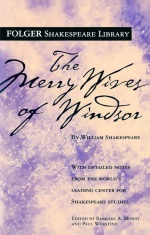The Merry Wives of Windsor: Difference between revisions
SophieByvik (talk | contribs) (Added Early Editions images) |
|||
| (7 intermediate revisions by 5 users not shown) | |||
| Line 8: | Line 8: | ||
== Productions at the Folger == | == Productions at the Folger == | ||
* [[The Merry Wives of Windsor (2020)|''The Merry Wives of Windsor'' (2020)]] | |||
== Early editions == | == Early editions == | ||
| Line 23: | Line 24: | ||
'''First Quarto''' | '''First Quarto''' | ||
:LUNA: [http://luna.folger.edu/luna/servlet/s/ | :LUNA: [http://luna.folger.edu/luna/servlet/s/5198x8/ First Quarto] | ||
:Hamnet: [http://shakespeare.folger.edu/cgi-bin/Pwebrecon.cgi?BBID=163951/ STC 22299] | :Hamnet: [http://shakespeare.folger.edu/cgi-bin/Pwebrecon.cgi?BBID=163951/ STC 22299] | ||
'''Second Quarto''' | '''Second Quarto''' | ||
:LUNA: [http://luna.folger.edu/luna/servlet/s/ | :LUNA: [http://luna.folger.edu/luna/servlet/s/87xhj1/ Second Quarto] | ||
:Hamnet: [http://shakespeare.folger.edu/cgi-bin/Pwebrecon.cgi?BBID=163952/ STC 22300 Copy 1] | :Hamnet: [http://shakespeare.folger.edu/cgi-bin/Pwebrecon.cgi?BBID=163952/ STC 22300 Copy 1] | ||
'''Third Quarto''' | '''Third Quarto''' | ||
:LUNA: [http://luna.folger.edu/luna/servlet/s/ | :LUNA: [http://luna.folger.edu/luna/servlet/s/a5u76j/ Third Quarto] | ||
:Hamnet: [http://shakespeare.folger.edu/cgi-bin/Pwebrecon.cgi?BBID=163953/ STC 22301] | :Hamnet: [http://shakespeare.folger.edu/cgi-bin/Pwebrecon.cgi?BBID=163953/ STC 22301] | ||
| Line 49: | Line 50: | ||
:Hamnet link to Folger Edition: [http://shakespeare.folger.edu/cgi-bin/Pwebrecon.cgi?BBID=189392/ PR2753 .M6 2003 copy 2 v.24] | :Hamnet link to Folger Edition: [http://shakespeare.folger.edu/cgi-bin/Pwebrecon.cgi?BBID=189392/ PR2753 .M6 2003 copy 2 v.24] | ||
| Line 61: | Line 58: | ||
== Translations == | == Translations == | ||
The Folger owns over 20 stand-alone translations of ''The Merry Wives of Windsor'' in various languages (not including collected works). Cataloging of these works is ongoing as of early 2015, and many have full-level catalog records, but some works still have only partial records. Translations can be found [[Hamnet]] in by searching for "Translations"in the '''Genre/Form Term''' field, or by searching the '''Call Number (Left-Anchored)''' field for call numbers starting with PR2796 (see the list of [[List of Sh.Col. call numbers#PR2796 .E2.80.93 Translations|Sh.Col. translations call numbers]] for specific language call numbers). Since not all translations are fully cataloged, some items may only turn up in one of these searches. | |||
== Performance materials == | == Performance materials == | ||
== Other media == | == Other media == | ||
===Image Group=== | |||
Explore the curated [https://luna.folger.edu/luna/servlet/s/m3c8dr image group] for ''The Merry Wives of Windsor'' in the Folger digital image collection. | |||
== Notes == | == Notes == | ||
<references> | <references /> | ||
[[Category: William Shakespeare's works]] | [[Category: William Shakespeare's works]] | ||
[[Category: Plays]] | [[Category: Plays]] | ||
[[Category: Comedies]] | [[Category: Comedies]] | ||
[[Category: The Merry Wives of Windsor]] | [[Category:The Merry Wives of Windsor|Merry Wives of Windsor, The]] | ||
[[Category: 17th century]] | [[Category: 17th century]] | ||
[[Category: Early modern drama]] | [[Category: Early modern drama]] | ||
Latest revision as of 09:12, 8 October 2021
In The Merry Wives of Windsor, one of William Shakespeare's plays, Shakespeare's "merry wives" are Mistress Ford and Mistress Page of the town of Windsor. The two play practical jokes on Mistress Ford's jealous husband and a visiting knight, Sir John Falstaff.
Merry wives, jealous husbands, and predatory knights were common in a kind of play called "citizen comedy" or "city comedy." In such plays, courtiers, gentlemen, or knights use social superiority to seduce citizens' wives.
The Windsor wives, though, do not follow that patter. Instead, Falstaff's offer of himself as lover inspires their torment of him. Falstaff responds with the same linguistic facility that Shakespeare gives him in the history plays in which he appears, making him the "hero" of the play for many audiences.
Scholars think Shakespeare wrote this play between 1597 and 1601. It was published as a quarto in 1602. A fuller, more readable text appeared in the 1623 First Folio in 1623. Sources likely included a story for Ser Giovanni Fiorentino's Il Pecorone (The Dunce) and Tarltons Newes out of Purgatorie.[1]
Productions at the Folger
Early editions
First Folio
- LUNA: First Folio: D2r - E6v
- Hamnet: STC 22273 Fo.1 no. 68
Second Folio
- LUNA: Second Folio: D2r - E6v
- Hamnet: STC 22274 Fo. 2 no. 07
First Quarto
- LUNA: First Quarto
- Hamnet: STC 22299
Second Quarto
- LUNA: Second Quarto
- Hamnet: STC 22300 Copy 1
Third Quarto
- LUNA: Third Quarto
- Hamnet: STC 22301
Modern editions
The Merry Wives of Windsor can be read online with Folger Digital Texts and purchased from Simon and Schuster.
- Hamnet link to Folger Edition: PR2753 .M6 2003 copy 2 v.24
In popular culture
Translations
The Folger owns over 20 stand-alone translations of The Merry Wives of Windsor in various languages (not including collected works). Cataloging of these works is ongoing as of early 2015, and many have full-level catalog records, but some works still have only partial records. Translations can be found Hamnet in by searching for "Translations"in the Genre/Form Term field, or by searching the Call Number (Left-Anchored) field for call numbers starting with PR2796 (see the list of Sh.Col. translations call numbers for specific language call numbers). Since not all translations are fully cataloged, some items may only turn up in one of these searches.
Performance materials
Other media
Image Group
Explore the curated image group for The Merry Wives of Windsor in the Folger digital image collection.
Notes
- ↑ Adapted from the Folger Library Shakespeare edition, edited by Barbara A. Mowat and Paul Werstine. © 2004 Folger Shakespeare Library.





